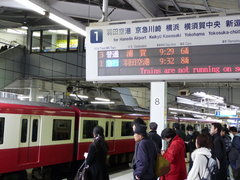Railways and Trains

Trains are the great equalizer of Japanese urban society. Unless you're part of the chauffeur-driven super-elite, or live in the kind of remote inaka where all the young people have buggered off to the nearest big city, chances are rail transport will play a major part in your every day life. Not just proximity to the station (always measured in terms of walking minutes, as walked by a 6ft tall marathon runner on barbiturates), but also distance from civilisation (in Tokyo that means the Yamanote Line) and the kind of trains that stop there (only losers live near stations where only "local" trains which dutifully stop at every station until their destination, usually with 5 minute breaks to let faster trains occupied by semi-elite winner types pass) will have a major influence on your social standing and also very likely how much rent you pay.
Japanese trains of all kinds are of course famed for their reliablity and punctuality. Unless of course someone has decided to try and insert themselves between train wheels and track, a kind of incident described circumspectly by the train operators as "jinshin jiko" (, literally "accident involving a human body"). Or a typhoon is brewing. Or, if you are travelling on the hideously interconnected Keisei - Asakusa - Keikyu set of lines, a spot of light rain. But even then all involved will do their utmost to inform passengers of what is happening, about what delays can be expected and alternative routes, and also apologise grovellingly at great length for the the inconvenience of the train being three minutes late. Which, if you boarded the train after it was delayed, doesn't make the slightest bit of difference because if the train had been on time you would have taken the one which should have come in four minutes after the delayed train, making you a minute early.
There is a downside to all this of course, and it is that everybody travels by train. For some reason trains are particularly popular in the morning, when residents of urban areas like to practice for an upcoming world record breaking attempt such as fitting the maximum possible number of people into a confined space such as a telephone box or one-room studio apartment. Cunning commuters can avoid involuntary participation by timing their commute to miss this so-called "rush hour", or by e.g. living in the centre of a conurbation and working in its suburbs and travelling in the other direction to the usually quite well-washed masses.
Train Lines by Region
Kanto Region
- Chiyoda Line (Tokyo Metro)
- Denen-Toshi Line
- Fukutoshin Line (Tokyo Metro)
- Ginza Line (Tokyo Metro)
- Hibiya Line (Tokyo Metro)
- Hanzomon Line (Tokyo Metro)
- Keihin-Tohoku Line (JR)
- Marunouchi Line (Tokyo Metro)
- Namboku Line (Tokyo Metro)
- Tokyo Monorail
- Tozai Line (Tokyo Metro)
- Yamanote Line (JR)
- Yurakucho Line (Tokyo Metro)